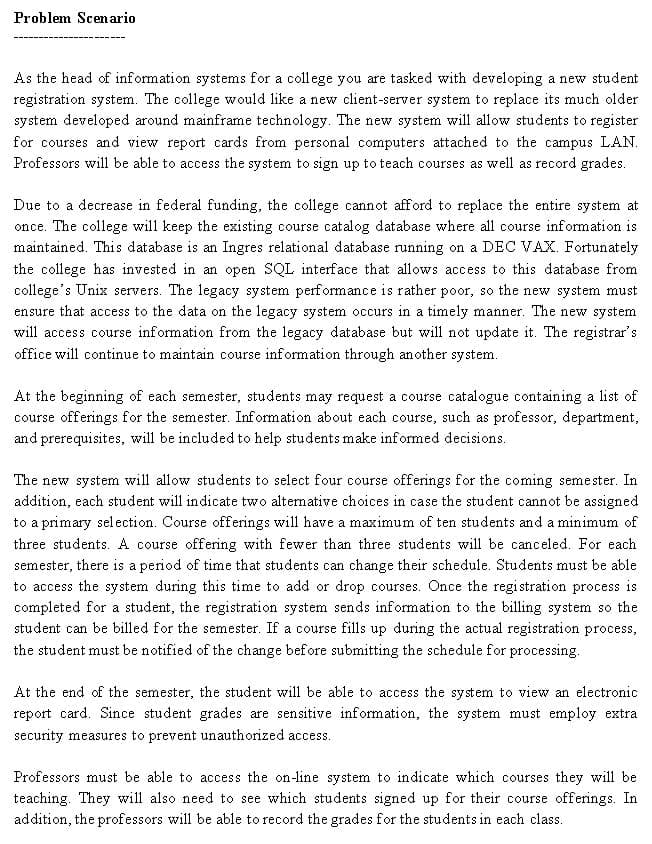Q :- Make a Class Diagram of given Scenerio. As the head of information systems for a college you are tasked with developing a new student registration system. The college would like a new client-server system to replace its much older system developed around mainframe technology. The new system will allow students to register for courses and view report cards from personal computers attached to the campus LAN. Professors will be able to access the system to sign up to teach courses as well as record grades. Due to a decrease in federal funding, the college cannot afford to replace the entire system at once. The college will keep the existing course catalog database where all course information is maintained. This database is an Ingres relational database running on a DEC VAX. Fortunately the college has invested in an open SQL interface that allows access to this database from college’s Unix servers. The legacy system performance is rather poor, so the new system must ensure that access to the data on the legacy system occurs in a timely manner. The new system will access course information from the legacy database but will not update it. The registrar’s office will continue to maintain course information through another system. At the beginning of each semester, students may request a course catalogue containing a list of course offerings for the semester. Information about each course, such as professor, department, and prerequisites, will be included to help students make informed decisions. The new system will allow students to select four course offerings for the coming semester. In addition, each student will indicate two alternative choices in case the student cannot be assigned to a primary selection. Course offerings will have a maximum of ten students and a minimum of three students. A course offering with fewer than three students will be canceled. For each semester, there is a period of time that students can change their schedule. Students must be able to access the system during this time to add or drop courses. Once the registration process is completed for a student, the registration system sends information to the billing system so the student can be billed for the semester. If a course fills up during the actual registration process, the student must be notified of the change before submitting the schedule for processing. At the end of the semester, the student will be able to access the system to view an electronic report card. Since student grades are sensitive information, the system must employ extra security measures to prevent unauthorized access. Professors must be able to access the on-line system to indicate which courses they will be teaching. They will also need to see which students signed up for their course offerings. In addition, the professors will be able to record the grades for the students in each class.
Q :- Make a Class Diagram of given Scenerio.
As the head of
Due to a decrease in federal funding, the college cannot afford to replace the entire system at once. The college will keep the existing course catalog
At the beginning of each semester, students may request a course catalogue containing a list of course offerings for the semester. Information about each course, such as professor, department, and prerequisites, will be included to help students make informed decisions.
The new system will allow students to select four course offerings for the coming semester. In addition, each student will indicate two alternative choices in case the student cannot be assigned to a primary selection. Course offerings will have a maximum of ten students and a minimum of three students. A course offering with fewer than three students will be canceled. For each semester, there is a period of time that students can change their schedule. Students must be able to access the system during this time to add or drop courses. Once the registration process is completed for a student, the registration system sends information to the billing system so the student can be billed for the semester. If a course fills up during the actual registration process, the student must be notified of the change before submitting the schedule for processing.
At the end of the semester, the student will be able to access the system to view an electronic report card. Since student grades are sensitive information, the system must employ extra security measures to prevent unauthorized access.
Professors must be able to access the on-line system to indicate which courses they will be teaching. They will also need to see which students signed up for their course offerings. In addition, the professors will be able to record the grades for the students in each class.

Step by step
Solved in 2 steps with 1 images









